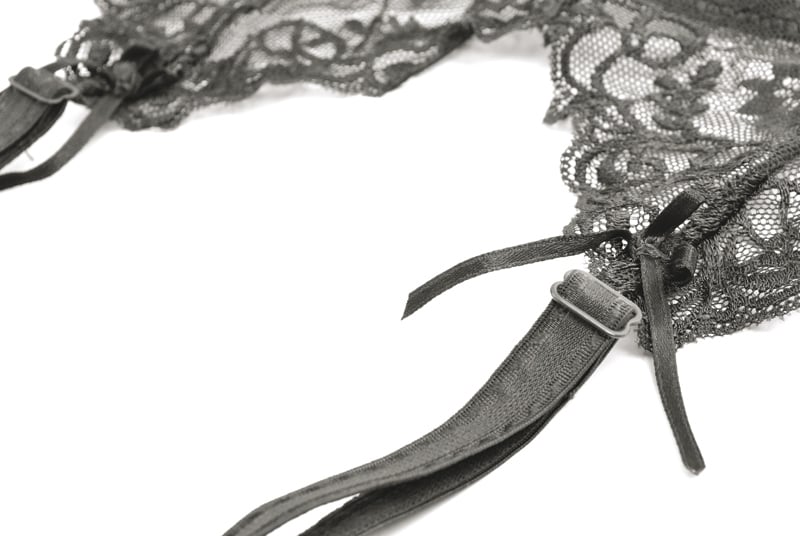
These 300-plus women are employees at one of the largest local manufacturers of women’s undergarments — a company that supplies bras, briefs, chemises, camisoles and nightwear to nearly 150 cities in Pakistan. Market research or official statistics indicating the full size of the undergarments business in the country are practically nonexistent. But those familiar with the trade confess that prospects of production and projected growth are huge.
Lift, support, enhance
Compared to the blossoming billion-dollar intimate apparel industry in the United States and Europe, Pakistan’s industry is underdeveloped. The gap between demand and supply is startlingly wide and the industry is largely neglected by the textile and hosiery associations. Three or four organised businesses meet a mere fraction of the demand. And even this number is not specifically tabulated, supervised or uplifted by regulatory government bodies.

More than 300 women work at the International Foundation Garment factory in Karachi, which supplies undergarments and nightwear to nearly 150 cities in Pakistan. PHOTO: ARIF SOOMRO
“I cannot tell you the size of the local market — it is very small in relation to its potential. But here is a back of the envelope calculation,” says Rafique Bhimjee, owner of IFG, whose brand’s target market is the educated middle class. He roughly estimates that if 30% of Pakistan’s 90 million-strong female population buys even three good quality bras per year, it translates to a potential sale of Rs81 million a year.
Bhimjee, who has been heading IFG since 1971, explains that without a dedicated lingerie association, the trade is unchartered and murky water to dive into. “The research is mostly independent and surveys are not carried out systematically,” he says, hinting that the credibility of the data given by independent surveyors is low. “It is a very difficult and tricky industry. The techniques are complicated and the manufacturing and sourcing of raw materials is a challenge.”
Most of the basic fabric used at the factory is local, made by suppliers who are largely non-serious about lingerie. Their interest in the business is minimal as there are much more lucrative ventures at hand. “During the summer, they are all so busy making lawn, they don’t even take our calls,” admits an amused Bhimjee. Important components such as straps, hooks, elastic, lace and accessories are imported from Thailand and Malaysia. The downside to importing such components is that the cycle is stretched out and orders need to be placed well in advance. Company owners must also adhere to the minimum quantity requirement, a stipulation that automatically raises costs. But despite these exasperating setbacks, Bhimjee has had relatively better support to set up shop than other local undergarment manufacturers.

Despite the high local demand, supply of undergarments has failed to keep up due to lack of research, infrastructure and investment in the industry. PHOTO: ARIF SOOMRO
When renowned international brand Triumph — one of the world’s largest lingerie manufacturers with over 125 years in production — set up the IFG factory in Karachi in the 1970s, it brought the technical expertise and necessary equipment with it. Spurred by an unpredictable security situation that discouraged foreign quality-control specialists or buyers from visiting, Triumph wound up operations in Pakistan a few years ago but continued to supply products. Upon its exit as a manufacturer, it left behind paraphernalia ranging from band knives and die cutting machines to size charts and detailed patterns — machines that IFG uses to make lingerie today. Bhimjee describes the present-day factory as an ‘assembly plant’ — much like Indus Motors Pakistan is for Toyota.
Local lingerie brand, BeBelle, has similar problems, but without the proficiency and inherited wisdom of IFG. Director sales and marketing at Bebelle, Kamran Naseem says his company has been struggling with technicalities since the brand’s inception in 1985.
“Unlike IFG, we don’t have designers,” he confesses. “We see samples of Victoria’s Secret bras and other such brands but don’t have skilled lingerie designers to copy the cut and finish. Our local guys try to imitate the design and structure, but if as much as one millimetre is off, the shape and comfort obviously go wrong.”

Busting mindsets
More than the relatively minor details of maximiser, cross-over and under-wired bras, the bigger problem is of tackling mindsets, says Naseem who supplies lingerie under the BeBelle label to 80 cities in Pakistan along with imported Thai bra, panty sets and nightwear. He highlights some alarming trends. “A survey conducted by various sales assistants revealed that 90% of women here only wear panties during the week of menstruation,” he says, adding that only women from the working or elite class wear underwear on a daily basis.

Most of the fabric used at the International Foundation Garment Factory, Karachi, is local. Other components such as hooks, elastic, lace and accessories are imported from Malaysia and Thailand. PHOTO: ARIF SOOMRO
Naseem indicates that about 80% of Pakistani buyers wear lingerie for basic use and are largely ignorant about style, fashion or comfort. “They don’t know much. Most don’t even know the difference between day and night wear. They are fixated on one size and don’t realise that things change with childbirth and weight gain.” He admits that duping women in this field is extremely easy since most of them are so unaware.
Another roadblock that prevents the industry from developing is Pakistani women’s orthodox fixation on the troika of colours. “I started when I was 16 and I am now 43, but nothing has changed,” says Naseem. “All they want is white, black and skin-coloured lingerie. We have tried baby pink, violet and vanilla but the response is very slow. Abroad, women are so evolved. They match their undergarments to their clothes.”
He attributes women’s nonchalance towards aesthetics to a lack of self-awareness and repressed sexuality. “On my wedding, my kurta was more expensive than my sherwani. Why? Because it made me feel good. Our women are the opposite. For example, one customer asked us to remove the wire from her underwire bra without realising its benefits or use. Customers are like that. They don’t care much for beauty or self-satisfaction,” he says, adding under his breath, “She can take the wire out and feel like Kareena Kapoor, but she doesn’t look it.”

Estimates suggest if 30% of Pakistan’s 90 million-strong female population buys even three good quality bras per year, it translates to a potential annual sale of Rs81 million. PHOTO: ARIF SOOMRO
He narrates another incident where a customer told a sales assistant that she didn’t want to buy pretty, colourful lingerie because she was scared of her husband’s reaction. “The husbands ask ‘why are you buying something so nice to wear inside? Who are you going to show it to?’”
Naseem also expresses his bewilderment about men being too involved with buying women’s daily lingerie. “In our culture, some families just don’t have a system that allows women to buy their own basics,” he says, adding that even undergarments sections within cosmetic stores often have male sales assistants. He feels that women are conscious of cameras in changing rooms and reluctant to buy lingerie in the presence of men in a shop, hence they would rather let their husband choose.
The chairperson of the Department of Psychiatry at Aga Khan University Hospital, Dr Murad Moosa Khan, says that this reinforcement of prejudiced male mentality can be explained by the way Pakistani society is organised in terms of gender rules.
“It fits into the notion of male dominance,” he says, adding that the trend is not specific to lingerie. “Many men control more than just the wardrobe element of a woman’s life; where she goes, whom she meets and what she spends are all under scrutiny.”

However, exceptions exist in the form of self-aware and informed urban females, such as 27-year-old Sheema Sohail. “My mother’s generation is still uncomfortable discussing undergarments or spending too much time and money on it. But for me, that’s where the outfit begins,” she says. For girls like Sheema, not only is underwear an important part of their aesthetic sensibilities but they are also willing to spend a substantial amount on acquiring the right item. Unfortunately, it does nothing for the local market since their purchases comprise mostly of foreign brands acquired during their trips abroad.
That, which shall not be shown
Marketing and advertising lingerie is as challenging as making or selling it. Manufacturers find themselves beating against a wall — how will they sell a product without showing it on a woman?
“We have to show the face, not figure,” says Bhimjee. “Even at established newspapers, the editorial staff is afraid of how an ad of a woman wearing lingerie will upset conservative elements. Sometimes, we are allowed to put up billboards and posters. Sometimes, we are not. We have to live with it.”
Naseem shares a similar story. When BeBelle started advertising in the late 1990s with Akhbar-e-Jahan, the publication was unwilling to push boundaries. “They weren’t allowed to show girls in sleeveless clothes, how were we to sell bras?” He explains that his team used colourful font and instead of pictures. Their motto at the time — ‘BeBelle, har libas se pehle’ — was the main focus.
Muji Manghi, general manager at Red Comm advertising agency, confirms the existence of taboo surrounding lingerie ads. “People here think that since underwear is dirty and taboo, it should be hidden. It is bizarre, because while a model can wear revealing clothes at fashion shows, modeling lingerie could spell the end of her career.” He suggests an alternate theme. “Selling underwear should not be about selling the woman, it’s about selling comfort and how a woman feels. I would show women feeling confident.”

Buckling up for competition
A locally manufactured bra is priced somewhere between Rs250 and Rs600. In most cases, it is not padded. There is no under-wire or silky fabric. It is simple and fits the purpose. But there are other kinds.
In the Shershah market in Karachi, second-hand garments — known locally as lunda — are stored in newly painted warehouses. A manager of one such godown, Rana Majid Khalid says that the clothes come in containers from Europe to Port Qasim and Mauripur. Each container, with a capacity to hold about 20,000kg, brings a fresh stock of used jackets, sweaters, bibs and lingerie. The invoice in his hand shows that a certain Danish and Noman Enterprises has paid £2,650 (Rs450,000 approximately) for nearly 21,000kg of clothes.
These goods are classified into A, B or C categories, depending on their condition. Buyers from the wholesale Haji Camp then purchase sets at Rs25 per kg to sell to small vendors who have stalls at weekly bazaars. The vendors sell them at prices competitive with locally made undergarments.
Mohammad Younus, a stall-keeper at Sunday Bazaar, Karachi, sits on the floor amidst a canopy of colourful bras and ladies underwear purchased from Shershah market. After his trip to the warehouse, Younus says his entire family starts laundry. They wash, iron and dry the undergarments before they are displayed at the bazaar. “White acha chalta hai,” he says, reconfirming the demand for basic lingerie.
Apart from the lunda, there are stalls in Sunday Bazaar, as well as various other markets in big cities, that sell seal-packed Thai and Chinese undergarments. At a small cosmetics store in Bohri Bazaar, Karachi, shopkeeper Mohammad Tariq has fiery red and hot pink bras — complete with diamante and lace details — on display alongside fairness creams, kohl sticks and facial scrubs. “IFG is strong here,” he says, when asked what customers are demanding. “But Chinese products have given others a run for their money because they are cheap and better quality.”
Bhimjee decries the availability of such low-priced products. “I am totally in favour of legal imports because the competition is good,” he says. “But the smuggled Chinese goods are very cheap and retailers are happy to keep them because it allows for high (profit) margins.” He feels that all imports should pay the same duties and taxes he pays for imported components. “The lack of import control makes the whole industry inefficient. We need a level playing field.”
Ultimately, Naseem points out that while the sources for undergarments are numerous, there are very few local companies providing premium products. “The demand for basics is there for sure. But there is a gap because not many suppliers are providing good quality stuff. Lots of people in Sialkot and Faisalabad are manufacturing bras and panties, but it is more for trade bulk export orders. They don’t care about selling here or establishing a quality brand. They just want money.”
The year 2013 marked the modern bra centenary. Mary Phelps Jacob, a New York socialite, invented the first modern brassiere when she felt she had no suitable undergarments for a recently purchased sheer evening gown. Unhappy with how the dress looked over a chunky whalebone corset, the 19-year-old improvised with a pair of silk handkerchiefs and a length of pink ribbon and the bra was born. A 100 years later, the undergarment industry in Pakistan is still struggling for their consumers to catch up with this attitude — that what lies beneath is as important as what meets the eye. Once these bare essentials find their due place in a woman’s mind, body and budget, the industry’s potential will know no bounds.
Atika Rehman is a former Express Tribune employee. She tweets @AtikaRehman
Published in The Express Tribune, Sunday Magazine, September 28th, 2014.


1719211536-0/BeFunky-collage-(81)1719211536-0-165x106.webp)



















COMMENTS
Comments are moderated and generally will be posted if they are on-topic and not abusive.
For more information, please see our Comments FAQ